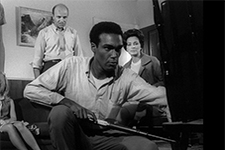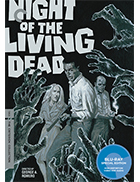Night of the Living Dead
|  Night of the Living Dead, a shoe-string independent movie produced outside of Pittsburgh by a group of filmmakers who had previously specialized in television commercials and industrial films, fundamentally reinvented the American horror film. Prior to its release in 1968, horror and science fiction movies were primarily filled with rubber monsters, lazy Psycho-imitation psychos, and tin-foil flying saucers, relegated to cheap drive-in theaters where the only people who watched them were teenagers more interested in their dates than what was on the movie screen. Night of the Living Dead changed all that. George A. Romero's black-and-white film about the horrors of consumption both literal and figurative caught the country by storm with its claustrophobic intensity, graphic violence, and documentary-like aesthetic. Perhaps it was just the right film at the right time. America in 1968 was being torn apart by street crime, social uprisings, political assassinations, and stark images of the Vietnam war on the living room television screen. Maybe there was something about Night of the Living Dead's vision of a world gone insane that simply struck a chord with discontented, unsettled, and fearful viewers. The lumbering, ravenous, reanimated dead were a ready-made metaphor for virtually everything that was scary, whether it be the dissolution of the family, the perils of consumerism, or the simple idea of being overwhelmed by the pressures of everyday life. Whatever it was (and I would submit it was all of that and more), Night of the Living Dead was, in every sense of the word, was a landmark. According to director John Carpenter, who would set his own horror landmark 10 years later with Halloween (1978), Romero "made the horror movie something to contend with." The plot is deceptively simple. It takes place over one night and follows a group of disparate people who have taken refuge in an isolated farmhouse because the recently deceased have mysteriously come back to life as lumbering zombies that hunt for human flesh. Romero and co-screenwriter John Russo imagine the farmhouse as a kind of microcosm of human existence, and they create realistic and moving human dilemmas among the various characters that, ironically, sometimes overshadow the ever-looming presence of the bloodthirsty ghouls outside. All throughout the film, the action in and around the farmhouse is put into context by radio reports and television newscasts that tell both the characters and the viewer what is going on in the world at large. From initial, vague radio reports about "unknown assassins," to television news coverage of government officials making meaningless statements like "Everything is being done that can be done," to footage of local hunters and police arming themselves to hunt down the ghouls, Night of the Living Dead heightens its already intense sense realism by evoking a media-saturated society trying to cope with the ultimate news story. In casting the lead role, Romero made the then-risky decision of choosing a black actor, Duane Jones, who was put in a place of consistent power and authority over the white characters around him. Jones's Ben is not only the most level-headed and leadership-capable member of the group, but he constantly undermines Harry Cooper (Karl Hardman), a loud, boorish white patriarch who is clearly used to running the show. Although race is never explicitly mentioned, the seething stares that Harry throws at Ben suggest quite clearly that his angers derives not only from being constantly shown that he is wrong, but being shown up-both intellectually and physically-by a capable black man. Romero has given conflicting accounts over the years of how Duane Jones came to be cast in the lead-at some points he has said that Jones was simply the best actor for the role, and at other points he has said he was trying to be purposefully subversive of the old racist social order-but the effect on the film is both clear and powerful, giving it a palpable undercurrent of racial tension that comes to a head in the film's brutal final moments when order is technically reasserted, but in a grim, fanatical, possibly regressive manner. The horror is both visceral and social. Night of the Living Dead is a fascinating exercise in style, in that it was made on an extremely low budget by a group of filmmakers who had never made a feature-length film, much less a horror film. However, they had spent years honing their craft producing commercials and industrial films, and many of the techniques they used to maintain visual interest and excitement in those formats translated quite impressively to generating and then maintaining a consistent state of suspense and tension in the film. The use of jagged expressionist shadow, low angles, constant cutting on motion, and a mix of traditional locked-down camera placement and documentary-style handheld camerawork keeps the film visual intriguing and emotionally engaging; there may have been little money to spend, but Romero and company were clearly invested in making the film look as good as possible. The same could be said for the soundtrack, which is composed entirely of prerecorded music cues from Capitol Library Services' Hi-Q music library, some of which had been previously used in B-movies like Teenagers From Outer Space (1959). Six different composers contributed cues, although the majority of them came from either Spencer Moore, who composed ethereal, otherworldly electronic tones, or George Hormel, who contributed more conventional orchestrations. Romero's mix of the two disparate styles matches the film's mix of visual styles, adding additional credence to both the extensive thought that went into the film's overall feel and the filmmakers' willingness to take chances and experiment, which helps align the film more with '60s European art cinema than '50s American drive-in schlock (it is no wonder that the Museum of Modern Art in New York scheduled it as part of its Cineprobe series in 1969). Much has been written about Night of the Living Deadover the past five decades (has it really been half a century already?), about both its horrific potency and its cultural and political significance. The film's various social implications should come as little surprise given that Romero grew up in the era of desegregation and the civil rights movement; he was an adolescent when Marlon Brando was threatening the squares in The Wild One, rock'n'roll was being invented, and American International Pictures was supplying a steady diet of teen-driven horror and science fiction schlock to drive-ins around the country. Romero and Russo were partially inspired by 1950s gory, shock-the-adults E.C. Comics titles like Tales From the Crypt and The Vault of Horror, which featured all manner of reanimated corpses, family members turning on each other, and viciously ironic narrative twists (not surprisingly, Romero went on to make 1982's Creepshow with Stephen King, an explicit homage to the horror comics of his childhood). What makes the film such a stark masterpiece is its effectiveness on multiple levels, as a physical, gut-wrenching horror film that leaves little to the imagination (early audiences were appalled-and fascinated-by the scenes of ghouls eagerly feasting on charred human intestines and dismembered limbs) and as a social metaphor. The screenplay was taken from an unpublished short story Romero had written called "Anubis," so-named after the Egyptian god of the dead. The story was written in three main parts, which eventually became Romero's initial zombie trilogy (Night was part one, followed by the even more ambitious Dawn of the Dead in 1978 and Day of the Dead in 1985). Romero's original story was intended as an allegory about the process of a new, revolutionary society overtaking an old, established order (which is exactly what people feared was happening the late '60s), and it is easy to see why such an interpretation might be read into the film. Night of the Living Dead works because it was envisioned with such single-minded clarity. From the frightened, bickering reactions of individual characters, to the panicked mobilization of the government, Night of the Living Dead is a perfect distillation of a society under siege; its sickly ironic ending, which leaves little resolved except the perpetuation of violence, is an disturbing capper that still rattles us to our core. However, while I would maintain that the allegorical meaning of Night of the Living Dead is important and worthwhile, in the end, this is primarily a horror film that frightens and unsettles. By trapping the characters early in the story and forcing them to work together against an impenetrable force, Romero and Russo create a horrifying human dilemma that has no escape. It is the inevitability of the scenario that makes the film so engrossing. You know these poor people are doomed, but you root for them anyway. Even if some of them are not particularly pleasant people, you are on their side because they represent individualistic humanity versus mindless conformism (well, there I go again, reading the metaphor). Yet, this is precisely what elevates Romero's film above its many, many imitators that tried to emulate the visceral horror without the corresponding understanding of the complexities of human behavior and relationships. Suffice it to say, Night of the Living Dead is gory, it is scary, and it is one of the most unrelenting, effective, and socially meaningful horror films ever made.
Copyright © 2018 James Kendrick Thoughts? E-mail James Kendrick All images copyright © The Criterion Collection | |||||||||||||||||||||||||||||||
Overall Rating: 


 (4)
(4)


